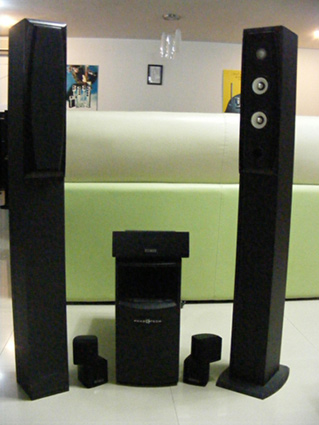 Montage Acoustics HD9001: Quadraphonic FM
Montage Acoustics HD9001: Quadraphonic FMIn 1969 Louis Dorren invented the Quadraplex system of single station, discrete, compatible four-channel FM broadcasting. There are two additional subcarriers in the Quadraplex system, supplementing the single one used in standard stereo FM. The baseband layout is as follows:
50 Hz to 15 kHz Main Channel (sum of all 4 channels) (LF+LR+RF+RR) signal, for mono FM listening compatibility.
23 to 53 kHz (cosine quadrature subcarrier) (LF+LR) - (RF+RR) Left minus Right difference signal. This signal's modulation in algebraic sum and difference with the Main channel was used for 2 channel stereo listener compatibility.
23 to 53 kHz (sine quadrature 38 kHz subcarrier) (LF+RF) - (LR+RR) Front minus Back difference signal. This signal's modulation in algebraic sum and difference with the Main channel and all the other subcarriers is used for the Quadraphonic listener.
61 to 91 kHz (cosine quadrature 76 kHz subcarrier) (LF+RR) - (LR+RF) Diagonal difference signal. This signal's modulation in algebraic sum and difference with the main channel and all the other subcarriers is also used for the Quadraphonic listener.
95 kHz SCA subcarrier, phase-locked to 19 kHz pilot, for reading services for the blind, background music, etc.
Home radio 1920's
In the 1920s the home radio evolved from a forbidding technological device which was esthetically unattractive and difficult to operate, to a consumer item, a piece of furniture, housed in an attractive wooden cabinet, with simple controls designed for anyone to operate, which occupied a place of honor in the living room. Prior to the introduction of the high-fidelity, long-playing record in the late 1940s, AM radio offered the highest sound quality available in a home audio device. Luxury models offered large speakers, "electric eye" tuning (a special type of vacuum tube, which provided a visual aid in tuning), mechanical push-button "memory" of favorite stations, sometimes with booklets of adhesive labels for the buttons with station call letters, and -- an inexpensive but impressive feature -- shortwave bands that allowed access to distant, often foreign, stations. Accessory, then factory-installed radios became available for cars.Montage Acoustics BT4480
Montage Acoustics: FM radio microphones
The FM broadcast band can also be used by some inexpensive wireless microphones, but professional-grade wireless microphones generally use bands in the UHF region so they can run on dedicated equipment without broadcast interference. Such inexpensive wireless microphones are generally sold as toys for karaoke or similar purposes, allowing the user to use an FM radio as an output rather than a dedicated amplifier and speaker.
Montage Acoustics reviews
The first commercial FM broadcasting stations
The first commercial FM broadcasting stations were in the United States, but initially they were primarily used to simulcast their AM sister stations, to broadcast lush orchestral music for stores and offices, to broadcast classical music to an upmarket listenership in urban areas, or for educational programming. By the late 1960s FM had been adopted by fans of "Alternative Rock" music ("A.O.R.—'Album Oriented Rock' Format"), but it wasn't until 1978 that listenership to FM stations exceeded that of AM stations in North America. During the 1980s and 1990s, Top 40 music stations and later even country music stations largely abandoned AM for FM. Today AM is mainly the preserve of talk radio, news, sports, religious programming, ethnic (minority language) broadcasting and some types of minority interest music. This shift has transformed AM into the "alternative band" that FM once was. (Some AM stations have begun to simulcast on, or switch to, FM signals to attract younger listeners and aid reception problems in buildings, during thunderstorms, and near high tension wires. Some of these stations now emphasize their presence on the FM dial.) Montage Acoustics
Montage Acoustics HD9001:Shortwave broadcasting
The discovery in the 1920s of the "skip" or "skywave" propagation mechanism, in which high frequency radio waves are reflected back to Earth beyond the horizon by the ionosphere, made the shortwave frequencies above 1 MHz, previously considered useless, a useful band for long distance broadcasting.